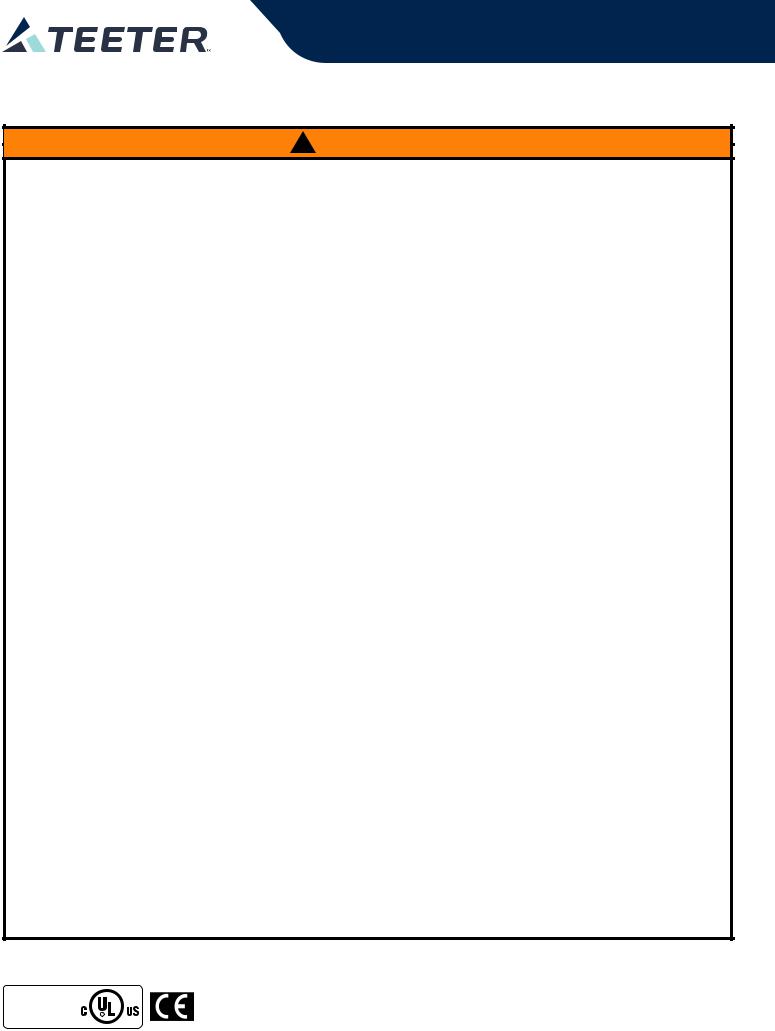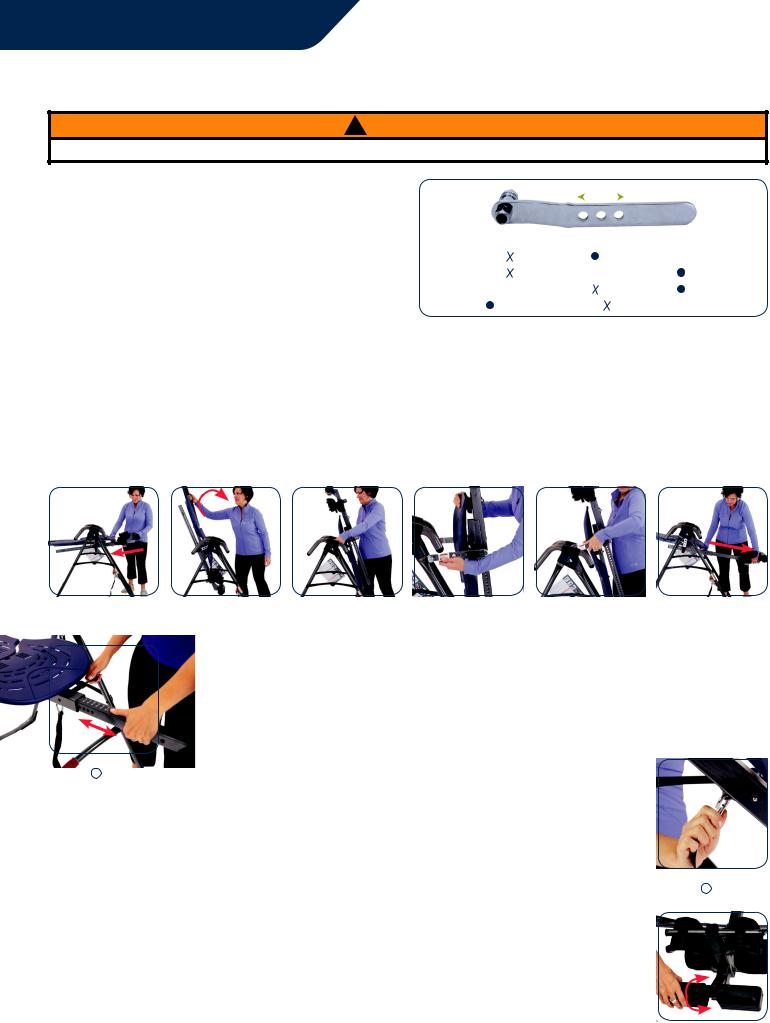Teeter EP-860 User Manual

EP-560™ & EP-860™ Inversion Table Owner’s Manual
For gravity-assisted stretching and decompression
IMPORTANT SAFETY INSTRUCTIONS
READ ALL INSTRUCTIONS BEFORE USING THE INVERSION TABLE
! WARNING
FAILURE TO FOLLOW INSTRUCTIONS AND WARNINGS COULD RESULT IN SERIOUS INJURY OR DEATH.
To reduce the risk of injury:
•Read and understand all the instructions, review all other accompanying documents, and inspect the equipment before using the inversion table. It is your responsibility to familiarize yourself with the proper use of this equipment and the inherent risks of inversion if these instructions are not followed, such as falling on your head or neck, pinching, entrapment, equipment failure, or aggravating a preexisting medical condition. It is the responsibility of the owner to ensure that all users of the product are fully informed about the proper use of the equipment and all safety precautions.
•DO NOT use until approved by a licensed physician. Inversion is contraindicated in any medical or health condition that may be made more severe by an elevation of blood pressure, intracranial pressure or mechanical stress of the inverted position, or that may impact your ability to operate the equipment. This may include injury or illness, but also the side effects of any drug or supplement (prescribed or over- the-counter). Specific conditions may include, but not be limited to:
·Any condition, neurological or otherwise, which results in unexplained tingling, weakness or neuropathy, seizure, sleep disorder, lightheadedness, dizziness, disorientation, or fatigue, or impacts strength, mobility, alertness, or cognitive ability;
·Any brain condition, such as trauma, history of intracranial bleed, history or risk of TIA or stroke, or severe headaches;
·Any condition of the heart or circulatory system, such as high blood pressure, hypertension, increased risk of stroke, or use of anticoagulants (including high doses of aspirin);
·Any bone, skeletal or spinal cord condition or injury, such as significant spinal curvature, acutely swollen joints, osteoporosis, fractures, dislocations, medullary pins or surgically implanted orthopedic supports;
·Any eye, ear, nasal or balance condition, such as trauma, history of retinal detachment, glaucoma, optic hypertension, chronic sinusitis, middle or inner ear disease, motion sickness, or vertigo;
·Any digestive or internal condition, such as severe acid reflux, hiatal or other hernia, gallbladder or kidney disease;
·Any condition for which exercise is specifically directed, limited or prohibited by a physician, such as pregnancy, obesity, or recent surgery.
•ALWAYS be certain the Ankle Lock System is properly adjusted and fully engaged, and that your ankles are secure before using the equipment. HEAR, FEEL, SEE and TEST that the Ankle Lock System is snug, close-fitting and secure EVERY TIME you use the equipment.
•ALWAYS wear securely tied lace-up shoes with a flat sole, such as a normal tennis-style shoe.
•DO NOT wear any footwear that could interfere with securing the Ankle Lock System, such as shoes with thick soles, boots, high-tops or any shoe that extends above the anklebone.
•DO NOT use the inversion table until it is adjusted properly for your height and body weight. Improper settings can cause rapid inversion or make returning upright difficult. New users, and users who are physically or mentally compromised, will require the assistance of a spotter. Make sure the equipment is set to your unique user settings prior to each use.
•DO NOT sit up or raise head to return upright. Instead, bend knees and slide your body to the foot-end of the inversion table to change weight distribution. If locked out in full inversion, follow the instructions for releasing from the locked position before returning upright.
•DO NOT continue using the equipment if you feel pain or become light-headed or dizzy while inverting. Immediately return to the upright position for recovery and eventual dismount.
•DO NOT use if you are over 6 ft 6 in (198 cm) or over 300 lbs. (136 kg). Structural failure could occur or head/neck may impact the floor during inversion.
•DO NOT allow children to use this machine. Keep children, bystanders, and pets away from machine while in use. The inversion table
is not intended for use by persons with reduced physical, sensory or mental capabilities, unless they are given supervision and instruction concerning use of the machine by a person responsible for their safety.
•DO NOT store the inversion table upright if children are present. Fold and lay the table on the floor. DO NOT store outdoors.
•DO NOT use aggressive movements, or use weights, elastic bands, any other exercise or stretching device or non-Teeter® attachments while on the inversion table. Use the inversion table only for its intended use as described in this manual.
•DO NOT drop or insert any object into any opening. Keep body parts, hair, loose clothing and jewelry clear of all moving parts.
•DO NOT use in any commercial, rental or institutional setting. This product is intended for indoor, home-use only.
•DO NOT operate equipment while under the influence of drugs, alcohol, or medication that may cause drowsiness or disorientation.
•ALWAYS inspect the equipment prior to use. Make sure all fasteners are secure.
•ALWAYS replace defective components immediately and/or keep the equipment out of use until repair.
•ALWAYS position equipment on a level surface and away from water or ledges that could lead to accidental immersion or falls.
•Refer to additional warning notices posted on the equipment. If a product label or Owner’s Manual should become lost, damaged or illegible, contact Customer Service for replacement.
DO NOT REMOVE. REPLACE IF DAMAGED OR REMOVED.
This product is Listed by Underwriters Laboratories Inc. Representative samples of this product have been evaluated by UL and meet applicable safety standards.
To download and print instructions, visit the product support page at teeter.com/product-support. Télécharger et imprimer le manuel, visitez la page d’assistance des produits au teeter.com/product-support. Descargar las instrucciones, visite la página de soporte de producto en teeter.com/product-support.

User Settings
EP-560™ & EP-860™ Owner’s Manual - 2
Product images throughout this document may vary from your model.
There are four (4) User Settings on your Teeter® that must be properly adjusted for your unique needs and body type. Take time to find your ideal settings. Every time prior to using the inversion table, make sure the User Settings are adjusted to your personal settings.
! WARNING
Failure to set these adjustments correctly may result in too rapid inversion or difficulty returning upright.
Roller Hinges: Select a Hole Setting
The Roller Hinges control the responsiveness or rate of rotation of the inversion table. There are three holes; the hole selection depends both on your body weight and the rotational responsiveness you desire (diagram right). For users just learning to use the inversion table, use the 'Beginner / Partial Inversion' setting.
Changing the Roller Hinge Setting
|
|
Most |
|
|
Least |
||
|
|
Responsive |
|
Responsive |
|||
|
A |
near Pivot Pin |
B Middle Hole |
|
opposite Pivot Pin |
||
|
Top Hole |
|
C Bottom Hole |
||||
80-120 lbs |
|
|
|
|
|
|
36-54 kg |
120-220 lbs |
|
|
|
|
|
|
54-100 kg |
220-300 lbs |
|
|
|
|
|
|
100-136 kg |
|
|
|
|
|
|
|
|
Beginner / Partial Inversion |
Suggested for Full Inversion |
1. Pull out the Height-Selector Locking Pin and slide the Main Shaft
in all the way to the very last hole (the storage setting near the Rear Ankle Cups). Release and engage the Pin (Figure 1).
2.Stand in front of the Table Bed and rotate it opposite from use (Figure 2) to rest against the Crossbar of the A-Frame.
3.Grasp each Roller Hinge under the Pivot Pins, using your thumbs to open the Self-Locking Hooks over the Pivot Pins (Figure 3). Lift both sides of the Table Bed out of the A-Frame and rest the head of the Table Bed on the floor.
4.Open each Cam Lock completely. Disengage the Roller Hinge from the Bracket Pin and slide it to the desired setting (Figure 4). Engage the Bracket Pin in the same Roller Hinge hole setting on each side. Secure the Cam Lock.
5.Re-attach the Table Bed into the A-Frame Hinge Plates (Figure 5). Ensure the Self-Locking Hooks snap closed over each Roller Hinge Pivot Pin. Rotate the Table Bed to the use position and adjust the Main Shaft for use (Figure 6).
Figure 1 |
Figure 2 |
Figure 3 |
Figure 4 |
Figure 5 |
Figure 6 |
Main Shaft: Determine a Height Setting
Figure 7
Labeled 1 Set Height right on the equipment!
1.Stand on the left side of the A-Frame. Pull out the Height-Selector Locking Pin with your right hand while sliding the Main Shaft out with your left (Figure 7). For ease of adjustment, lower the Main Shaft below horizontal to lengthen and raise the Main Shaft above horizontal to shorten.
2.Start by sliding the Main Shaft until the last setting you can read is one inch greater than your height (e.g. if you’re 5’10”/178 cm, the last numbers visible will be 5’11”/180 cm). This helps to ensure that the rotation
of the table is not too fast. You will test to see if this setting is right for you later. Your ideal height setting will depend on your weight distribution and could vary several inches on either side of your actual height.
3. Release the spring-loaded Height-Selector Locking Pin to fully engage a hole setting. Use caution to prevent pinching fingers. Ensure the Pin passes
completely through the Main Shaft.
Angle Tether: Pre-Set the Angle
Attach the Angle Tether to the U-Bar under the Table Bed (Figure 8) to limit the degree of rotation. Slide the buckle to lengthen or shorten the tether to pre-set your desired maximum inversion angle, or unclip the tether altogether when you are ready to rotate into full inversion.
Figure 8
Labeled 2 Set Angle right on the equipment!
Ankle Comfort Dial™: Find Your Setting
The Ankle Comfort Dial rotates into a High (1) or Low (2) setting (Figure 9), with a one inch height variance. Set the Ankle Comfort Dial so the Front & Rear Ankle Cups secure around the smallest part of your ankles (with minimal distance between the Ankle Lock System and the top of your foot). This will reduce body slide on the Table Bed while inverted, which can cause a shift in weight distribution and interfere with the ease of which you can control your rotation.
Figure 9
